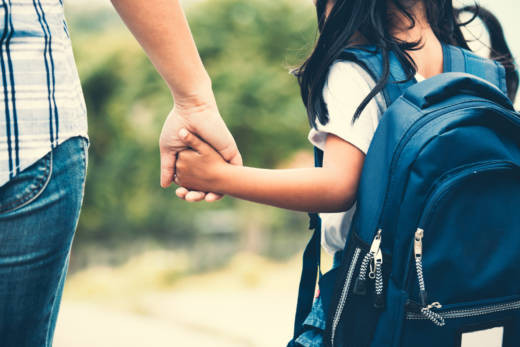In this way, teachers are uniquely positioned to ameliorate some of the effects of early trauma. “The adults in the school environment may be the most stable and mentally well people [some children] have contact with,” said Jennings. “Their teachers can become role models for them for what a healthy adult is like. School can become a sanctuary for kids like this.”
Preschool and kindergarten teachers play an especially important role because children's early classroom experiences influence their perception of school for years to come. Jennings said that a caring kindergarten teacher can help these children “learn that adults, generally, are people who can provide support to them, even if their parent cannot.” That’s one reason the preschool suspension and expulsion rates are troubling. They disrupt yet another adult-child relationship and reinforce feelings of instability. As early childhood expert Suzanne Bouffard noted, “Young children who are suspended are often the ones who need the most social and academic support — and they end up missing opportunities to get it.”
Building a Trauma-Sensitive Classroom Environment
Let Go of Zero Tolerance: Zero tolerance policies and harsh classroom discipline models can “trigger reactions that amplify feelings of trauma,” said Jennings. Punitive measures can retraumatize children and “reinforce in their mind that the world is a dangerous place, that people don’t like them, and that they are no good.”
Teachers need the flexibility to de-escalate a situation rather than administer a prescriptive consequence. Ultimately, these students need to learn how to de-escalate situations themselves and regulate their emotions, said Jennings, “and the only way they can learn that is in a place that feels safe.”
Reframe Student Behavior: It’s easy for teachers to take students’ behavior personally or to misinterpret a child’s actions as willful defiance. Jennings said that teachers should “remember that behaviors that are disruptive or unhelpful in the classroom might be self-protective responses to chronic stress.” This perspective can help teachers make a small but powerful mental shift: instead of asking “what’s wrong with him?” ask “what happened to him, and how did he learn to adapt to it?”
For example, “Hypervigilance can really help when you are in a dangerous situation. A child who is hypervigilant may be adept at noticing small changes and reacting quickly.” But this same hypervigilance will “make it really hard to focus and dive deeply into the reading material.”
Children who experience food scarcity may have a tendency “to quickly grab or hoard things.” These kids might fail the famous marshmallow experiment simply because “they don’t trust that the second marshmallow is really coming,” said Jennings. “In the context of their lives, this is an adaptive response that makes sense.”
Cultivating this kind of empathy takes practice, says Jennings. It means developing “the ability to stop yourself from reacting with your habitual tendencies, take a breath and reflect” on the child in front of you. When teachers take the perspective of a student, “things really shift.”
Generate and Savor Positive Emotions: Because teachers don’t always know which students are coming to school with traumatic backgrounds – and because they have an obligation to teach all learners – educators “have to consider universal approaches that help everybody and embrace those kids who need it most.” Developing a strong classroom community is foundational to this work.
When children suffer from trauma exposure, they are on high alert for potential threats. Teachers can intentionally help students “recognize and savor” small, special moments in the classroom, said Jennings. “Help the class pay attention to what it feels like to feel good. Enjoy positive emotions together as a community. Not only do you get to help kids who don’t get to feel those positive emotions as much, but you also create bonds between students in your classroom – and that is exactly what they need.”
This can be as simple as celebrating acts of kindness, pausing after a good moment to soak up the feeling in the room, and using tools such as morning meetings to foster a respectful classroom culture. “When teachers cultivate community, students who have experienced trauma come to believe, ‘I am part of this community. They accept me, they care about me, and they want to help me. I belong here.’ That’s something all kids can benefit from,” said Jennings.
Draw on the Power of Story: Children with trauma backgrounds need plenty of opportunities to learn about, experience and practice compassion and resilience. Literature is a powerful vehicle to support this endeavor, said Jennings. Stories and books can broaden students’ perspectives, giving them a window into how other people feel, bounce back from challenges and develop healthy relationships.
“As you read a story to a group of children, ask ‘How do you think this person is feeling in this story? Can you imagine if you were a person in this story? How would that feel to you?’” said Jennings. Reading aloud isn’t just for elementary school classrooms. According to one study, even teenagers benefit from hearing about how scientists approached failure and setbacks. (For two curated lists of books related to kindness and compassion, click here and here.)
Put On Your Oxygen Mask First: In Jennings’ work, she focuses first on helping teachers develop resilience, self-awareness, and self-regulation -- and then on how they can teach these tools to children.
She said that teachers need to learn how to manage their own stress that comes with navigating students’ trauma-related behavior. Jennings devotes a chunk of her book to teacher self-care and includes this resilience self-reflection survey that helps teachers think about their own ability to “navigate and recover from adversity.”
How do we best teach children about compassion and resilience? First and foremost, adults must remember that “kids learn these skills through imitating us,” said Jennings. “If we don’t embody them, our instruction won’t work. It will come off as phony. If we are not behaving the way we want them to behave, we are being hypocritical -- and they know it.”


